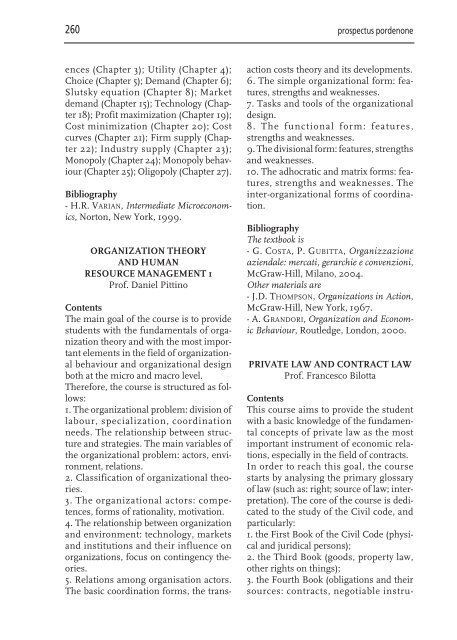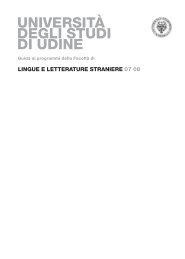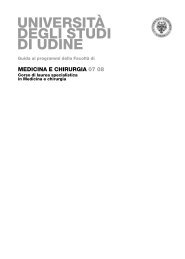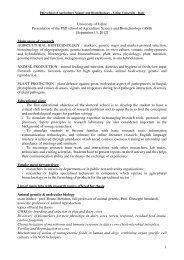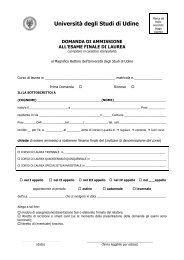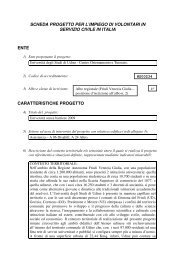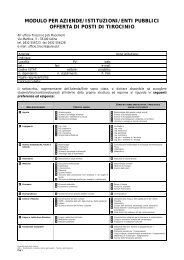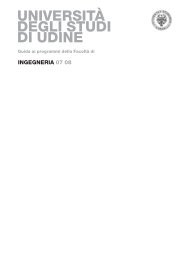â¢GUIDA ECONOMIA 07-08 - Università degli studi di Udine
â¢GUIDA ECONOMIA 07-08 - Università degli studi di Udine
â¢GUIDA ECONOMIA 07-08 - Università degli studi di Udine
You also want an ePaper? Increase the reach of your titles
YUMPU automatically turns print PDFs into web optimized ePapers that Google loves.
260 prospectus pordenone<br />
ences (Chapter 3); Utility (Chapter 4);<br />
Choice (Chapter 5); Demand (Chapter 6);<br />
Slutsky equation (Chapter 8); Market<br />
demand (Chapter 15); Technology (Chapter<br />
18); Profit maximization (Chapter 19);<br />
Cost minimization (Chapter 20); Cost<br />
curves (Chapter 21); Firm supply (Chapter<br />
22); Industry supply (Chapter 23);<br />
Monopoly (Chapter 24); Monopoly behaviour<br />
(Chapter 25); Oligopoly (Chapter 27).<br />
Bibliography<br />
- H.R. VARIAN, Interme<strong>di</strong>ate Microeconomics,<br />
Norton, New York, 1999.<br />
ORGANIZATION THEORY<br />
AND HUMAN<br />
RESOURCE MANAGEMENT 1<br />
Prof. Daniel Pittino<br />
Contents<br />
The main goal of the course is to provide<br />
students with the fundamentals of organization<br />
theory and with the most important<br />
elements in the field of organizational<br />
behaviour and organizational design<br />
both at the micro and macro level.<br />
Therefore, the course is structured as follows:<br />
1. The organizational problem: <strong>di</strong>vision of<br />
labour, specialization, coor<strong>di</strong>nation<br />
needs. The relationship between structure<br />
and strategies. The main variables of<br />
the organizational problem: actors, environment,<br />
relations.<br />
2. Classification of organizational theories.<br />
3. The organizational actors: competences,<br />
forms of rationality, motivation.<br />
4. The relationship between organization<br />
and environment: technology, markets<br />
and institutions and their influence on<br />
organizations, focus on contingency theories.<br />
5. Relations among organisation actors.<br />
The basic coor<strong>di</strong>nation forms, the transaction<br />
costs theory and its developments.<br />
6. The simple organizational form: features,<br />
strengths and weaknesses.<br />
7. Tasks and tools of the organizational<br />
design.<br />
8. The functional form: features,<br />
strengths and weaknesses.<br />
9. The <strong>di</strong>visional form: features, strengths<br />
and weaknesses.<br />
10. The adhocratic and matrix forms: features,<br />
strengths and weaknesses. The<br />
inter-organizational forms of coor<strong>di</strong>nation.<br />
Bibliography<br />
The textbook is<br />
- G. COSTA, P. GUBITTA, Organizzazione<br />
aziendale: mercati, gerarchie e convenzioni,<br />
McGraw-Hill, Milano, 2004.<br />
Other materials are<br />
- J.D. THOMPSON, Organizations in Action,<br />
McGraw-Hill, New York, 1967.<br />
- A. GRANDORI, Organization and Economic<br />
Behaviour, Routledge, London, 2000.<br />
PRIVATE LAW AND CONTRACT LAW<br />
Prof. Francesco Bilotta<br />
Contents<br />
This course aims to provide the student<br />
with a basic knowledge of the fundamental<br />
concepts of private law as the most<br />
important instrument of economic relations,<br />
especially in the field of contracts.<br />
In order to reach this goal, the course<br />
starts by analysing the primary glossary<br />
of law (such as: right; source of law; interpretation).<br />
The core of the course is de<strong>di</strong>cated<br />
to the study of the Civil code, and<br />
particularly:<br />
1. the First Book of the Civil Code (physical<br />
and juri<strong>di</strong>cal persons);<br />
2. the Third Book (goods, property law,<br />
other rights on things);<br />
3. the Fourth Book (obligations and their<br />
sources: contracts, negotiable instru-


